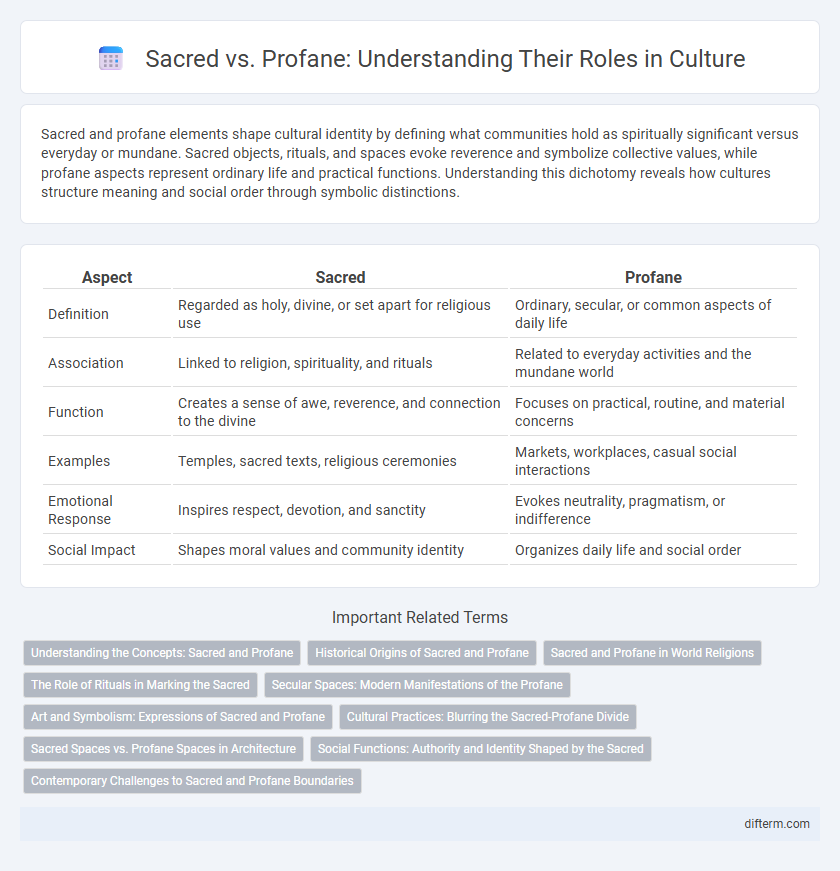Sacred and profane elements shape cultural identity by defining what communities hold as spiritually significant versus everyday or mundane. Sacred objects, rituals, and spaces evoke reverence and symbolize collective values, while profane aspects represent ordinary life and practical functions. Understanding this dichotomy reveals how cultures structure meaning and social order through symbolic distinctions.
Table of Comparison
| Aspect | Sacred | Profane |
|---|---|---|
| Definition | Regarded as holy, divine, or set apart for religious use | Ordinary, secular, or common aspects of daily life |
| Association | Linked to religion, spirituality, and rituals | Related to everyday activities and the mundane world |
| Function | Creates a sense of awe, reverence, and connection to the divine | Focuses on practical, routine, and material concerns |
| Examples | Temples, sacred texts, religious ceremonies | Markets, workplaces, casual social interactions |
| Emotional Response | Inspires respect, devotion, and sanctity | Evokes neutrality, pragmatism, or indifference |
| Social Impact | Shapes moral values and community identity | Organizes daily life and social order |
Understanding the Concepts: Sacred and Profane
The concepts of sacred and profane are foundational in understanding cultural systems of meaning, where the sacred represents elements set apart by religious or spiritual significance, often evoking awe and reverence. The profane encompasses everyday, ordinary experiences devoid of sacred qualities, forming the practical backdrop against which sacred rituals and symbols gain prominence. This dichotomy shapes social behaviors and collective identities by delineating what is considered holy, untouchable, or forbidden versus mundane and accessible.
Historical Origins of Sacred and Profane
The historical origins of sacred and profane concepts trace back to ancient religious rituals where sacred spaces and objects were set apart to signify divine presence, contrasting with profane elements representing the ordinary or mundane. Emile Durkheim's foundational work highlighted how early societies created a dichotomy between sacred and profane to establish social cohesion and shared belief systems. These distinctions played a crucial role in the development of cultural norms, influencing religious practices and community identity across civilizations.
Sacred and Profane in World Religions
Sacred and profane represent fundamental concepts in world religions, distinguishing what is considered holy, divine, or spiritually significant from the ordinary or mundane aspects of life. The sacred often involves rituals, symbols, and spaces that connect adherents to a higher power or transcendental reality, as seen in practices across Christianity, Hinduism, Islam, and indigenous belief systems. Understanding the dichotomy between sacred and profane allows for deeper insights into religious ceremonies, moral codes, and cultural identities that shape human experience globally.
The Role of Rituals in Marking the Sacred
Rituals play a crucial role in distinguishing the sacred from the profane by creating structured actions that symbolize and reinforce cultural beliefs. These ceremonial practices, found in religions worldwide, facilitate communal participation and transmit shared values through symbolic language and gestures. By marking transitions or significant events, rituals help communities maintain a clear boundary between ordinary life and sacred experiences.
Secular Spaces: Modern Manifestations of the Profane
Secular spaces serve as modern manifestations of the profane, embodying societal values detached from religious or sacred connotations. These environments, including commercial centers, government buildings, and entertainment venues, facilitate everyday interactions grounded in practicality and temporal concerns. The differentiation highlights cultural dynamics where ritualistic reverence yields to functional engagement within contemporary urban life.
Art and Symbolism: Expressions of Sacred and Profane
Art and symbolism serve as powerful expressions of the sacred and profane, reflecting deep cultural meanings and societal values. Sacred art often incorporates religious icons, rituals, and motifs that evoke transcendence, spirituality, and divine presence. In contrast, profane art engages with everyday life, secular experiences, and mundane realities, using symbolism that emphasizes human creativity and worldly existence.
Cultural Practices: Blurring the Sacred-Profane Divide
Cultural practices often blur the sacred-profane divide by embedding spiritual significance within everyday rituals and objects, transforming mundane activities into profound expressions of identity and belief. Festivals, ceremonies, and communal gatherings serve as platforms where the sacred intermingles with the profane, reinforcing collective memory and social cohesion. This dynamic interplay challenges rigid distinctions, highlighting fluid boundaries shaped by historical context and cultural interpretation.
Sacred Spaces vs. Profane Spaces in Architecture
Sacred spaces in architecture are designed to evoke spiritual connection, often characterized by symbolism, ritual function, and intentional separation from ordinary life, such as temples, churches, and mosques. Profane spaces serve everyday, secular purposes, emphasizing functionality and accessibility in homes, offices, and commercial buildings. The distinction between sacred and profane spaces highlights cultural values, shaping human experience through architectural elements that convey meaning and social order.
Social Functions: Authority and Identity Shaped by the Sacred
Sacred symbols and rituals serve as powerful tools for establishing social authority and reinforcing group identity within communities. The distinction between sacred and profane realms legitimizes leadership roles and societal norms, creating a cohesive cultural framework. Emile Durkheim emphasized that collective belief in the sacred fosters social solidarity and defines community boundaries.
Contemporary Challenges to Sacred and Profane Boundaries
Contemporary challenges to the boundaries between the sacred and profane emerge from globalization, digital communication, and cultural hybridity, which blur traditional distinctions and transform ritual practices. Secularization and commercialization intensify conflicts over sacred spaces, symbols, and narratives, often leading to debates about cultural appropriation and identity. Social media platforms amplify these tensions by enabling widespread reinterpretation and contestation of sacred meanings across diverse communities.
sacred vs profane Infographic

 difterm.com
difterm.com